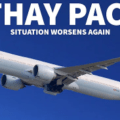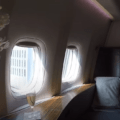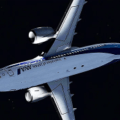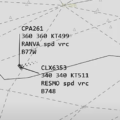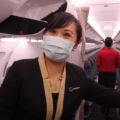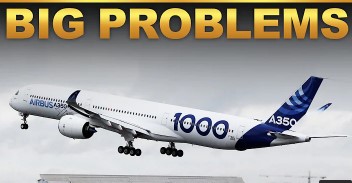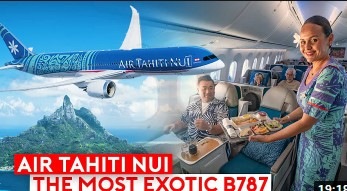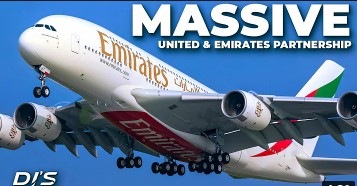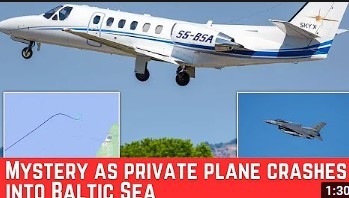Cathay Pacific

| IATA ICAO Callsign CX CPA CATHAY | |
|---|---|
| Founded | 24 September 1946 |
| Hubs | Hong Kong |
| Focus cities | Taipei–Taoyuan |
| Frequent-flyer program | Asia Miles Marco Polo Club |
| Alliance | Oneworld |
| Subsidiaries | Air Hong Kong Cathay Dragon HK Express Asia Miles |
| Fleet size | 155 |
| Destinations | 79 |
| Parent company | Swire Pacific (45.00%) Air China (29.99%) Qatar Airways (9.99%) |
| Traded as | SEHK: 293 |
| Headquarters | Cathay City, Hong Kong International Airport, Chek Lap Kok, Hong Kong |
| Key people | Patrick Healy (Chairman) Augustus Tang (CEO) |
| Revenue | |
| Operating income | |
| Profit | |
| Total equity | |
| Employees | More than 34,200 (2019, incl. subsidiaries) |
| Website | www.cathaypacific.com |
Cathay Pacific Airways Ltd. (CPA), more widely known as Cathay Pacific, is the flag carrier of Hong Kong, with its head office and main hub located at Hong Kong International Airport. The airline’s operations and subsidiaries have scheduled passenger and cargo services to more than 190 destinations in more than 60 countries worldwide including codeshares and joint ventures. Cathay Pacific operates a fleet consisting of Airbus A330, Airbus A350 and Boeing 777 wide-body aircraft. Cathay Pacific Cargo operates two models of the Boeing 747. Wholly owned subsidiary airline Cathay Dragon operates to 44 destinations in the Asia-Pacific region from its Hong Kong base. In 2010, Cathay Pacific and Cathay Pacific Cargo, together with Cathay Dragon, carried nearly 27 million passengers and over 1.8 million tons of cargo and mail.
The airline was founded on 24 September 1946 by Australian Sydney H. de Kantzow and American Roy C. Farrell. The airline celebrated its 70th anniversary in 2016; and as of March 2018, its major shareholders are Swire Pacific, with a 45% stake and Air China, with a 29% stake.
Cathay Pacific is the world’s tenth largest airline measured by sales, and fourteenth largest measured by market capitalisation. In 2010, Cathay Pacific became the world’s largest international cargo airline, along with main hub Hong Kong International Airport as the world’s busiest airport measured by cargo traffic. The company slogan is Move beyond.
It is one of the founding members of the Oneworld alliance. Cathay Pacific’s subsidiary Cathay Dragon is an affiliate member of Oneworld.
History
1946–1960: The early years

Cathay Pacific Airways was founded on 24 September 1946 in Hong Kong. Sydney “Syd” de Kantzow, Roy Farrell, Neil Buchanan, Donald Brittan Evans and Robert “Bob” Stanley Russell were the initial shareholders. Buchanan and Russell already worked for de Kantzow and Farrell at Roy Farrell Import-Export Company, the predecessor of Cathay Pacific, which was initially headquartered in Shanghai. Both de Kantzow and Farrell were ex-air force pilots who had flown the Hump, a route over the Himalayan mountains. Farrell purchased the airline’s first aircraft, a Douglas DC-3, nicknamed Betsy, at Bush Field, New York City in 1945.: The company began freight services on 28 January 1946 from Sydney to Shanghai, after Farrell and Russell flew the plane to Australia and obtained a license to carry freight (but not passengers) earlier that month. Its first commercial flight was a shipment of Australian goods. The profitable business soon attracted attention from the Republic of China government officials. After several instances where the company’s planes were detained by authorities in Shanghai, on 11 May 1946 the company relocated, flying its two planes to Hong Kong. Farrell and de Kantzow re-registered their business in Hong Kong on 24 September 1946 as Cathay Pacific Airways Limited, while another sister company, The Roy Farrell Export Import Company (Hong Kong) Limited, was incorporated on 28 August 1946 and chartered some flights from Cathay. (According to International Directory of Company Histories, two companies were formed for tax purposes.)
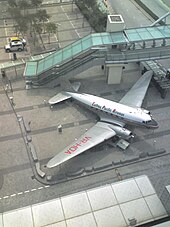
They named the airline Cathay, the ancient name given to China, and Pacific because Farrell speculated that they would one day fly across the Pacific (which happened in the 1970s). Moreover, to avoid the name “Air Cathay” as it had already been used in a comic. The Chinese name for the company (“國泰”) was not settled on until the 1950s. It comes from a Chinese idiom meaning “peace and prosperity” and was at the time often used by other businesses called “Cathay” in English.
According to legend, the airline’s unique name was conceived by Farrell and some foreign correspondents at the bar of the Manila Hotel, while another narrative was the name was taken in the Cathay Hotel in Shanghai Bund, during drinking and brainstorming, and choosing Cathay was to avoid the word China in the airline name. On Cathay Pacific’s maiden voyage, de Kantzow and Peter Hoskins flew from Sydney to Hong Kong via Manila. The airline initially flew routes between Hong Kong, Sydney, Manila, Singapore, Shanghai, Saigon, Bangkok, with additional chartered destinations. The airline grew quickly. By 1947, it had added another five DC-3s and two Vickers Catalina seaplanes to its fleet.
In 1948, a new legal person of Cathay Pacific Airways was incorporated, with John Swire & Sons (now known as Swire Group), China Navigation Company, Australian National Airways being the new shareholders of the new entity,[11] acquiring the assets from the old legal person; the old legal person, was renamed into Cathay Pacific Holdings, as well as retaining 10% shares of the new Cathay Pacific Airways. de Kantzow, Farrell and Russell were the shareholders of Cathay Pacific Holdings at that time. It was reported that the colonial British government of Hong Kong, required the airline was majority-owned by the British. Despite de Kantzow being a British subject through his Australian roots, Farrell was an American, thus forcing them to sell their majority stake. Under Swire’s management, de Kantzow remained in the airline until 1951, while Farrell had sold his minority stake in Cathay Pacific soon after Swire’s takeover in 1948, due to his wife’s health problems. He returned to Texas and became a successful businessman.
Swire later acquired 52% of Cathay Pacific Airways.[citation needed] As of 31 December 2017, the airline is still 45% owned by Swire Group through its subsidiary Swire Pacific Limited, as the largest shareholder. However, Swire Group also formed a shareholders’ agreement with the second largest shareholder Air China (which was controlled by state-owned China National Aviation Holding), which Cathay Pacific and Air China had a cross ownership.
In the late 1940s, the Hong Kong government divided the local aviation market between Cathay Pacific and its only local competitor, the Jardine Matheson-owned Hong Kong Airways: Cathay Pacific was allocated routes to the south (including South-East Asia and Australia), while Hong Kong Airways was allocated routes to the north (including mainland China, Korea, and Japan). The situation changed with the establishment of the People’s Republic of China and the Korean War, which reduced the viability of the northern routes. In 1959, Cathay Pacific acquired Hong Kong Airways,[16] and became the dominant airline in Hong Kong.
Under Swire, another important sister company, HAECO, was established in 1950.[13]:130 Nowadays, it’s one of the major aeroplane repair service companies of Hong Kong with divisions in other cities of China.
1960–1990: Expansion

Source: Communi core by S.Fujioka
The airline prospered in the late 1950s and into the 1960s, and it purchased Hong Kong Airways, on 1 July 1959.[23] Between 1962 and 1967, the airline recorded double digit growth on average every year and became one of the world’s first airlines to operate international services to Fukuoka, Nagoya and Osaka in Japan. In 1964, it carried its one millionth passenger[citation needed] and acquired its first jet engine aircraft, the Convair 880. In 1967, it became an all jet airline with the replacement of its last Lockheed L-188 Electra with a Convair 880.
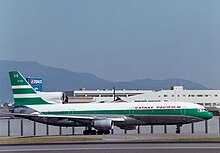
Source: Communi core by S.Fujioka
In the 1970s, Cathay Pacific installed a computerised reservation system and flight simulators. In 1971, Cathay Pacific Airways received the first Boeing aircraft 707-320B. By 1972 it had five 707s. The new aircraft colour was known as Brunswick green. In July 1976 it began operating a Boeing 707 freighter from Hong Kong to Seoul, Bangkok and Singapore.
In 1974, Cathay Pacific almost purchased the McDonnell Douglas DC-10 to open a new flight route. During the flight route application process with the British government, due to the pressure from the British government, Cathay Pacific changed the application to apply for a route from Hong Kong to London using a Boeing 747. The application was ultimately rejected. In 1979, the airline acquired its first Boeing 747 and applied for traffic rights to fly to London in 1980, with the first flight taking place on 16 July.
Expansion continued into the 1980s. In 1982, Cathay Pacific Airways introduced Cathay Pacific Cargo, which provided cargo service to ingratiate the trend of Hong Kong, becoming one of the largest re-export trading ports of the world. The airline’s long-haul dedicated cargo services started a twice a week with Hong Kong-Frankfurt-London service operated jointly with Lufthansa. Cathay Pacific kept its service to Vancouver in 1983, with service on to San Francisco in 1986, when an industry-wide boom encouraged route growth to many European and North American centres including London, Brisbane, Frankfurt, Amsterdam, Rome, Paris, Zurich and Manchester.
On 15 May 1986, the airline went public and was listed in the Main Board of the Stock Exchange of Hong Kong.
1990–2000: Rebranding, renewal, and Oneworld
In January 1990, Cathay Pacific and its parent company, Swire Pacific, acquired a significant shareholding in Dragonair, and a 75% stake in cargo airline Air Hong Kong in 1994. In 1994, the airline launched a program to upgrade its passenger service, including a HK$23 million program to update its image. Its logo was updated in 1994 and again in 2014.

Top: The plane still bearing the Union flag taxing at Paris Charles de Gaulle International Airport (CDG / LFPG) in May 1993.
Bottom: The same aircraft in 1995 at Frankfurt Airport without the Union Flag, two years before the 1997 handover.
Source: This file has been extracted from another file: Boeing 747-467, Cathay Pacific Airways AN0664119.jpg and Cathay Pacific Boeing 747-467; VR-HOR@FRA;10.10.1995 (5471579306).jpg
The airline began a fleet replacement program in the mid-1990s, which cost a total of US$9 billion. In 1996, CITIC Pacific increased its holdings in Cathay Pacific from 10% to 25%, and two other Chinese companies, CNAC(G) and CTS, also bought substantial holdings, while the Swire Group holding was reduced to 44%. According to the International Directory of Company Histories, the sale of a 12.5% stake of Cathay Pacific by Swire Pacific to a Chinese state-owned company was regarded “as evidence of China’s sincerity in maintaining the prosperity of Hong Kong.”
In 1997, Cathay Pacific updated the registration numbers and flags on its fleet in conjunction with the handover of Hong Kong from the United Kingdom to China.
On 21 May 1998, Cathay Pacific took the first delivery of the Boeing 777-300 at a ceremony in Everett. On 21 September 1998, Cathay Pacific, together with American Airlines, British Airways, Canadian Airlines, and Qantas, co-founded the Oneworld airline alliance. Cathay Pacific temporarily took over the domestic and international operations of Philippine Airlines during its two-week shutdown from 26 September to 7 October 1998. The airline was hurt by the Asian financial crisis of the late 1990s, but recorded a record HK$5 billion profit in 2000.
Transfer to Chek Lap Kok and transpolar flights
On Monday, 6 July 1998, Cathay Pacific terminated flights from Kai Tak International Airport to London Heathrow Airport after over 73 years of operation. The next day, Cathay Pacific began flights from New York John F. Kennedy International Airport to the new Hong Kong International Airport at Chek Lap Kok. This flight was also the world’s first nonstop transpolar flight from New York to Hong Kong.
2000–2010: Industrial troubles and acquisitions

Source: Adrian Pingstone (Arpingstone)
The 2000s saw Cathay Pacific experience labour relations issues while completing the acquisition of Dragonair.
The 49ers – employment dispute
In 2001, the Hong Kong Aircrew Officers Association (HKAOA) launched a “work to rule” campaign to further its campaign for pay improvements and changes to roster scheduling practices. The action involved pilots refusing to work flights that were not scheduled on their roster. Although this alone did not cause extensive disruption, rostered pilots began to call in sick for their flights. Combined with the work to rule campaign, the airline was unable to cover all of its scheduled flights, and cancellations resulted. Cathay Pacific steadfastly refused to negotiate with the HKAOA under threat of industrial action.
On 9 July 2001, reportedly following a comprehensive review of the employment histories of all its pilots, the company fired 49 of its 1,500 pilots. This group became known colloquially as “the 49ers”. Nearly half of the fired pilots were captains, representing five percent of the total pilot group. Of the 21 officers of the HKAOA, nine were fired, including four of the seven union negotiators.
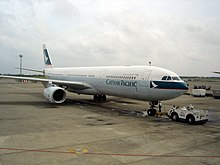
Source: Jefferry at English Wikipedia
Then-HKAOA president Captain Nigel Demery took the view that “the firing was pure intimidation, a union-bust straight up, designed to be random enough to put the fear in all pilots that they might be next, no reason given”.The dismissals were challenged in a number of legal proceedings, but none were reinstated. The airline later offered the 49 pilots it terminated in 2001 the chance to reapply for pilot positions with its cargo division, guaranteeing such applicants first interviews, subject to passing psychometric testing. Nineteen former employees applied and twelve were offered jobs.
On 11 November 2009, 18 of the 49ers succeeded in the Hong Kong Court of First Instance concerning their joint claims for breach of contract, breach of the Employment Ordinance, and defamation.
Judge Anselmo Reyes ruled that the airline had contravened the Employment Ordinance by dismissing the pilots without a valid reason, adding that they had been sacked primarily because of union activities. He also held that remarks by then chief operating officer Philip Chen Nanlok and current chief executive Tony Tyler after the sackings were defamatory. The judge handed the pilots a victory in their long-running legal battle, with individual awards of HK$3.3 million for defamation together with a month’s pay and HK$150,000 for the sackings.
On 24 December 2010, judges Frank Stock, Susan Kwan and Johnson Lam of the Court of Appeal overturned the judgment of the lower court to the extent that the claim for wrongful termination of the contract was dismissed. The finding that Cathay Pacific wrongly sacked the 18 pilots for their union activities was upheld. The court upheld the defamation claim but reduced the damages for the defamatory comments made by Cathay Pacific management. The judges also modified the judgment awarding payment of legal costs to the pilots and instead said that they should now pay some of Cathay’s costs.
The leader of the 49er Plaintiffs, Captain John Warham, launched a book titled The 49ers – The True Story on 25 March 2011.
The pilots were awarded leave on 26 October 2011 to take their case to the Court of Final Appeal. The matter was heard before Hon. Mr. Justices Bokhary, Chan and Ribeiro who are all Permanent Judges of the Court of Final Appeal. The matters to be decided upon by the Court concerned wrongful termination of contract and the level of damages for defamation. The case was heard by the Court of Final Appeal on 27 August 2012.
On 26 September 2012, 11 years after they were sacked, the 49ers were finally judged[50] to have won the 3 prime issues of their legal case: breach of contract, breach of the Employment Ordinance, and defamation. The Court of Final Appeal agreed with the Court of Appeal’s methodology for reducing the defamation damages. However, it reinstated one month’s salary for each of the 49ers.
Regarding breach of contract, the overall picture leading to dismissal and events immediately after were analysed by the courts, not just the dismissal letter. Regarding the Employment Ordinance, an important aspect was that the judge defined the scope of “union activities” and its protection for workers in Hong Kong. The Court concluded: “Accordingly, most (possibly all) union-sponsored action is potentially protected by s 21B(1)(b), but if the action is not carried out “at [an] appropriate time”, it is excluded from the provision”. There was no challenge by Cathay Pacific to the Court of Appeal’s decision to uphold the original Judge’s conclusion that the statements made by Cathay Executives were defamatory of the plaintiffs.
John Warham, referring to the effect the fight has had on pilots’ families, said: “In terms of human life, three people are dead because of what Cathay Pacific did to us. That’s on their conscience, I hope they can live with that.”
Acquisition and downsizing of Dragonair
On 28 September 2006, the airline underwent a shareholding realignment under which Dragonair became a wholly owned subsidiary but continued to operate under its brand. Acquiring Dragonair meant gaining more access to the restricted, yet rapidly growing, Mainland China market and more opportunities for sharing of resources. CNAC, and its subsidiary, Air China, acquired a 17.5 percent stake in Cathay Pacific, and the airline doubled its shareholding in Air China to 17.5 percent. CITIC Pacific reduced its shareholding to 17.5 percent and Swire Group reduced its shareholding to 40 percent.

Source: The original uploader was Cipher01 at Japanese Wikipedia.
Dragonair had originally planned significant international expansion. It was already operating services to Bangkok and Tokyo, and was to have a dedicated cargo fleet of nine Boeing 747-400BCF aircraft by 2009 operating to New York, Los Angeles, Chicago, San Francisco and Columbus. It had also acquired three Airbus A330-300 aircraft to commence services to Sydney and Seoul.
Following the acquisition by Cathay Pacific, Dragonair’s proposed expansion plans underwent a comprehensive route compatibility analysis with the Cathay network to reduce duplication. Dragonair services to Bangkok and Tokyo were terminated, and new services launched to Sendai, Phuket, Manila, and Kathmandu. With the merging of similar departments at the two previously separate airlines, some Dragonair staff have had their employment contracts transferred to Cathay Pacific, except Dragonair Pilots and Cabin Crew and others made redundant due to the efficiencies gained in the merger. This resulted in an approximately 37 percent decrease in the amount of staff contractually employed by Dragonair.
In January 2016, Cathay Pacific announced it was rebranding Dragonair as Cathay Dragon.
Economic challenges

Source: Myself (Adrian Pingstone).
In September 2008, three of Cathay Pacific’s top ten global accounts, Lehmann Brothers, AIG and Merrill Lynch, hit financial trouble.

In March 2009, the airline reported a record full-year loss of HK$8.56 billion for 2008, which was also the carrier’s first since the 1997 Asian Financial Crisis. The record loss included fuel-hedging losses of HK$7.6 billion and a HK$468 million charge for a price-fixing fine in the US It had to scrap its final dividend. The hedging losses were a result of locking in fuel prices at higher than the prevailing market price. As of the end of 2008, Cathay Pacific has hedged about half of its fuel needs until the end of 2011. The airline at the time estimated that it would face no further cash costs from the hedges if the average market price stood at US$75, enabling it to recoup provisions it made in 2008.
The flattening out of fuel prices resulted in Cathay Pacific recording a paper fuel hedging gain for its half-year reports for 2009. However, as a result of the global economic situation, the Group reported an operating loss. Given the current economic climate, and in line with the steps being taken by other major airlines around the world, the airline has undertaken a comprehensive review of all its routes and operations. This has resulted in frequencies being reduced to certain destinations, ad hoc cancellations on other routes, deferred capital expenditure, parked aircraft and introduced a Special Leave Scheme for staff to conserve money.[64] According to CEO Tony Tyler, the yield from passengers was “hugely down” and the airline had lost “a lot of premium traffic”. He noted that it could take 20 passengers in economy to make up for the lost revenue of one fewer first class passenger flying to New York from Hong Kong.
Current developments

In 2010, the airline set another record high profit, amounting to HK$14.05 billion despite record losses set in the same decade. At the same time, Cathay Pacific had taken delivery of several new aircraft types, including the Airbus A330-300 and Boeing 777-300ER. Tony Tyler left his position as CEO at the airline on 31 March 2010 to pursue his new job at the IATA. Chief operating officer John Slosar had succeeded as the new CEO. In addition, New Zealand’s Commerce Commission had dropped charges against Cathay Pacific concerning the air cargo price-fixing agreements. In 2014, the airline underwent the largest network expansion in recent years which included the addition of links to Manchester, Zurich and Boston
On 8 October 2016, Cathay Pacific retired their last passenger Boeing 747 (a 747-400 with reg B-HUJ) with a farewell scenic flight around Hong Kong after over 35 years of service of the type. Cathay operated the 747 since August 1979, when it was inaugurated on services to Australia.
During the first half of 2016, Cathay Pacific’s passenger yields fell 10 per cent, to the lowest in seven years as competing airlines from Mainland China increased direct service to the U.S. and Europe, hurting the company’s revenue from its Hong Kong hub. In October, Cathay Pacific scrapped its profit forecast for the second half of the year, less than two months after its issuance.
From 15 September 2016, Cathay Pacific decided to reintroduce fuel surcharge on many flights after its half-year net profits dropped over 80% and it suffered HK$4.5 billion loss from wrong bets on fuel prices. As of September 2016, Oil prices were halved from 2014 and stayed below US$50 a barrel.
2018 data breach
In 2018, the airline discovered a data breach. Data of around 9.4 million passengers was compromised during the breach, with 860,000 passport numbers, 245,000 Hong Kong identity card numbers, 403 expired credit card numbers, and 27 credit card numbers without CVV being accessed. However, no passwords were stolen. The breach was suspected in March 2018, but was confirmed only in May 2018. In March 2020, the company was fined £500,000 (U.S. $639,600) by the British Information Commissioner’s Office (ICO) and avoided the heftier penalty of U.S. $564 million under the European Union’s GDPR-derived data privacy laws, which were not in force during the discovery of the breach.
2017–2019 transformation
Under new leadership, the airline started to transform its business after suffering from 2 years of consecutive loss. The strategy focuses on 5Ps – Places, Planes, Product, People, and Productivity to find new sources of revenue, deliver more value to its customers and improve efficiency and productivity.
The airline restructured its organization to be more agile and faster in decision making as well as responding to customers’ needs. It has also launched 13 new routes since 2017, introduced a wide range of changes to its service, including bringing back hot meals on its most busy route between Hong Kong and Taipei, designed an inflight menu that features famous Hong Kong dishes served in all cabins, and revamped its Business Class service proposition to provide more choice, more personalization, better presentation and improved quality in its food and beverages offerings.
The airline has also invested significantly in other hard product and digital offerings such as an upgraded website, new or refurbished lounges across its network, including the first airline lounge yoga studio at The Pier – Business in Hong Kong. Wifi was introduced in 2017 and will be retrofitted across its fleet by 2020.
In February 2019, the airline issued a profit alert to the Hong Kong Stock Exchange indicating a profit of HK$2.3 billion for the 2018 financial year, signalling early signs of success of its transformation.
Acquisition of HK Express
On 27 March 2019, Cathay Pacific officially announced it would acquire HK Express, the only low-cost carrier in Hong Kong, citing to “expect synergies in generating a new business model and is a practical way to support long-term development and to enhance competitiveness”. The transaction takes Cathay Pacific HK$4.93 billion total. The transaction is closed in July 2019 and HK Express has become Cathay Pacific’s wholly owned subsidiary.
Hong Kong protests and COVID-19
During the 2019–20 Hong Kong protests, Cathay Pacific employees participated in protests at Hong Kong International Airport. The Beijing government, which is a shareholder in Cathay Pacific, ordered Cathay to suspend any employees who participated in the protest. Cathay Chairman, John Slosar, responded saying, “We employ 27,000 staff in Hong Kong doing all sorts of different jobs … we certainly wouldn’t dream of telling them what they have to think about something.” Cathay Pacific later suspended a pilot who was arrested during a protest, and CEO Rupert Hogg declared his support of the government, and reiterated that employees who violated the company’s code of conduct could be dismissed. On 16 August, Hogg resigned due to “intense criticism” from Chinese authorities as a result of Cathay staff participating in the protests. “Chief customer and commercial officer”, Paul Loo, also resigned. By late September, Cathay Pacific and Cathay Dragon had terminated the employment of 31 aviation professionals or forced their resignations on the basis of their participation in protests or expressions of support for them.
Cathay Pacific reduced international flights during the COVID-19 pandemic, which negatively impacted the aviation industry and flight demands, while also causing travel bans globally. 96% of flights have already been slashed for the months of March, April and May, and the group’s subsidiary HKExpress is currently suspending all flight operations from 23 March to 30 April 2020, due to reduced demand. At one point during the crisis, only 582 passengers flew with Cathay Pacific in an entire day.
Recapitalization and government bailout
On 9 June 2020, Cathay Pacific, Swire Pacific and Air China halted stock trade pending the announcement. On 10 June, Cathay Pacific and the Government of Hong Kong jointly announced a HK$39 Billion recapitalization plan and rescue package for Cathay Pacific. In the rescue package, the Government of Hong Kong will be issued HK$19.5 Billion dividend-paying preference shares and HK$1.95 billion of warrants, giving it 6% stake. The stake of the three major stakeholders, Swire Pacific, Air China and Qatar Airways will fall to 42%, 28% and 9.4% due to the government stake. Also, Cathay Pacific will receive a HK$7.8 billion bridging loan and the Government would have the right to appoint two observers on Cathay’s board. Finance Secretary of HKSAR Government, Paul Chan, said “It is not our intention to become a long term shareholder of Cathay Pacific.”
Corporate affairs, identity and senior leadership

Source: WhisperToMe
Cathay Pacific’s head office, Cathay City, is located at Hong Kong International Airport. Cathay City was scheduled to be built in increments between April and September 1998. The headquarters opened in 1998. Previously the airline’s headquarters were at the Swire House, which was a complex in Central named after the airline’s parent company.
Subsidiaries and associates
Cathay Pacific has diversified into related industries and sectors, including ground handling, aviation engineering, inflight catering.
Companies with Cathay Pacific Group stake include:
| Air China | Corporate | Airline | China | 20% |
| Air China Cargo | Joint Venture | Cargo airline | China | 49%** |
| AHK Air Hong Kong Limited | Subsidiary | Cargo airline | Hong Kong | 100% |
| Airline Property Limited | Subsidiary | Property Investment | Hong Kong | 100% |
| Airline Store Property Limited | Subsidiary | Property Investment | Hong Kong | 100% |
| Asia Training Property Limited | Subsidiary | Property Investment | Hong Kong | 100% |
| Asia Miles Limited | Subsidiary | Travel Reward | Hong Kong | 100% |
| Cathay Holidays Limited | Subsidiary | Tour Operator | Hong Kong | 100% |
| Cathay Pacific Aero Limited | Subsidiary | Financial Services | Hong Kong | 100% |
| Cathay Pacific Aircraft Lease Finance Limited | Subsidiary | Aircraft Leasing | Hong Kong | 100% |
| Cathay Pacific Aircraft Services Limited | Subsidiary | Aircraft Acquisition | Isle of Man | 100% |
| Cathay Pacific Catering Services (HK) Limited | Subsidiary | Catering services | Hong Kong | 100% |
| Cathay Pacific MTN Financing Limited | Subsidiary | Financial services | Cayman Islands | 100% |
| Cathay Pacific Services Limited | Subsidiary | Cargo | Hong Kong | 100% |
| Cebu Pacific Catering Services Inc. | Joint Venture | Airline catering | Philippines | 40% |
| Dell Fresh Limited | Subsidiary | Catering | Hong Kong | 100% |
| Ground Support Engineering Limited | Joint Venture | Airport ground engineering support and equipment maintenance | Hong Kong | 50% |
| Global Logisticcs System HK Company Limited | – | Air Cargo Computing | Hong Kong | 95% |
| Guangzhou Guo Tai Information Processing Company Limited | Subsidiary | Information processing | China | 100% |
| HAECO ITM Ltd. | Joint Venture | Inventory technical management services | Hong Kong | 30% |
| Hong Kong Airport Services Limited | Subsidiary | Ground handling | Hong Kong | 100% |
| Hong Kong Aviation and Airport Services Limited | Subsidiary | Propert Investment | Hong Kong | 100% |
| Hong Kong Dragon Airlines Limited | Subsidiary | Airline | Hong Kong | 100% |
| Hong Kong Express Airways | Subsidiary | Airline | Hong Kong | 100% |
| LSG Lufthansa Service Hong Kong Limited | – | Airline catering | Hong Kong | 32% |
| Shanghai International Airport Services Co., Limited | Joint Venture | Ground handling | China | 25% |
| Snowdon Limited | Subsidiary | Financial services | Hong Kong | 100% |
| Troon Limited | Subsidiary | Financial services | Hong Kong | 100% |
| Vogue Laundry Service Limited | Subsidiary | Laundry and Dry Cleaning | Hong Kong | 100% |
**Shareholding held through subsidiary at 25%, another 24% held through an economic interest with total holding at 49%
Livery
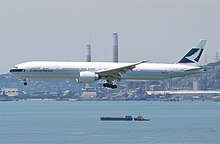
Source: Aero Icarus from Zürich, Switzerland

Source: BenYung0531
Before November 1994, all Cathay Pacific aircraft used a “green lettuce” livery and carried the British flag on the empennage. After the handover, aircraft carry the Brand Hong Kong logo and with HONG KONG or in Chinese 香港 under or beside the Brand Hong Kong logo instead of using the Hong Kong Special Administrative Region (HKSAR) flag. The HKSAR flag has never appeared on any aircraft.
All Cathay Pacific aircraft carry the following livery, logos and trademarks: the “brushwing” livery on the body and on the vertical stabiliser, introduced in the early 1990s, and was first deployed on a Boeing 747-400 (VR-HOT, re-registered as B-HOT), ahead of the launch of Airbus A340 service for Cathay Pacific. It also features the “Asia’s world city” brandline, the Brand Hong Kong logotype and the dragon symbol; the Oneworld logo and the Swire Group logo.
The brushwing logo consists of a calligraphic stroke against a green background; the stroke is intended to appear like the wing of a bird. The previous logo, consisting of green and white stripes, was in place from the early 1970s until 1994.
In November 2015, the airline revealed a refreshed version of its previous livery, featuring a simpler paint scheme while maintaining their trademark brushwing on an all-green tail. It was first unveiled on a Boeing 777-300ER (B-KPM), in preparation for the delivery of the first Airbus A350 for Cathay Pacific. The second aircraft was a freighter aircraft, Boeing 747-400ERF (B-LIA).
Chief Executive Officer / Managing Director
Chief Executive Officers were referred to as Managing Directors before 1 July 1998.
- John Bremridge (until 1970)
- Duncan Bluck (1971–1979)
- Michael Miles (1979–1984)
- Peter Sutch (1984–1992)
- Rod Eddington (1992–1996)
- David Turnbull (1996–2005)
- Philip Chen (2005–2007)
- Tony Tyler (2007–2011)
- John Slosar (2011–2014)
- Ivan Chu (2014–2017)
- Rupert Hogg (2017–2019)
- Augustus Tang (2019– )
Destinations
Cathay Pacific serves 79 destinations (including cargo), but not including codeshare in 46 countries and territories on five continents, with a well-developed Asian network. The airline serves many gateway cities in North America and Europe, with easy connections with its Oneworld and codeshare partners, American Airlines and British Airways via Los Angeles and London, respectively. Also, the airline serves 10 French cities via a codeshare partnership with French national rail operator, SNCF, from Paris. The airline also has access to over 17 destinations in China through its subsidiary, Cathay Dragon.
Codeshare agreements
Cathay Pacific has codeshare agreements with the following airlines:
- Air Astana
- Air Canada (Selected connecting routes)
- Air China
- Air New Zealand
- Alaska Airlines
- American Airlines
- Austrian Airlines
- Bangkok Airways
- British Airways
- Brussels Airlines
- Cathay Dragon (Subsidiary)
- Comair
- Fiji Airways
- Finnair
- Hong Kong Express
- Iberia
- Japan Airlines
- LATAM Airlines Group
- Lufthansa
- Malaysia Airlines
- MIAT Mongolian Airlines
- Philippine Airlines
- Qantas
- Qatar Airways
- S7 Airlines
- Shenzhen Airlines
- Swiss International Air Lines
- Vietnam Airlines
- WestJet
The airline also has a codeshare agreement with French high speed trains (SNCF) from TGV station at Paris-Charles de Gaulle Airport to ten French cities. as well as codeshare agreement with ferry operators – Cotai Water Jet and Chu Kong Passenger Transport Co., Ltd to connect passengers from Hong Kong to Macao, Zhuhai, Shenzhen, Shekou and Guangzhou in the Greater Bay Area. In addition, there is a codeshare agreement with Bahrain Limo for bus services between Bahrain and Dammam.
Fleet

N509FZ
Cathay Pacific operates an all-wide-body, twin-engine commercial fleet composed of Airbus A330, Airbus A350, Boeing 777 aircraft and a Boeing 747 cargo fleet. The airline also has more Airbus A350 and Boeing 777X aircraft on order.
Loyalty programs
Cathay Pacific has two loyalty programs: The loyalty program Marco Polo Club and Asia Miles, the travel reward program. Members of Marco Polo are automatically enrolled as Asia Miles members.
Marco Polo Club
The Marco Polo Club is divided into four tiers, Green (entry level), Silver, Gold, and Diamond, based on the member’s past travel. A joining fee of US$100 is applicable for a Marco Polo Club membership. Members earn Club Points on eligible fare classes with Cathay Pacific, Cathay Dragon and Oneworld member airlines. These are used to calculate the member’s eligibility for membership renewal, upgrade or downgrade during the membership year. Higher-tiered members are provided with increased travel benefits such as guaranteed Economy Class seat, additional baggage allowance, priority flight booking and airport lounge access. The Marco Polo Club membership is terminated after 12 months of inactivity or failure to meet minimum travel criteria as outlined in the membership guide and will be downgraded to Asia Miles member.
Green
The Green tier is the entry level to the Marco Polo Club. Benefits include dedicated 24-hour club service line for flight reservations, designated Marco Polo check-in counters, excess baggage allowance and lounge access redemption, and priority boarding. One Business Class lounge voucher will be issued for the member or their travelling companion at reaching 200 Club Points. Members are required to earn 20 Club Points or pay US$100 for membership renewal.
Silver
Silver tier level is achieved or retained when the member earns 300 Club Points during the membership year. Additional benefits for Silver Card members include advanced seat reservations, priority waitlisting, Business Class check-in counters, 10 kg (22 lb) extra baggage allowance, priority baggage handling, and Business Class lounge access when flying Cathay Pacific or Cathay Dragon operated flights. Additionally, members are eligible to use the Frequent Visitor e-Channels for seamless self-service immigration clearance at Hong Kong International Airport. At 450 Club Points, members will be issued two Business Class lounge vouchers for their travelling companions. Also, members are entitled to apply for at most three Membership Holidays in their lifetime, retaining their status for one year for each application.
Marco Polo Club Silver tier status is equivalent to Oneworld Ruby tier status, which entitles members to Oneworld Ruby benefits when travelling on a Oneworld member airline.
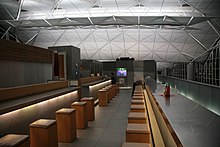
Source: https://www.flickr.com/photos/richardmoross/
Gold tier level is achieved or retained when the member earns 600 Club Points during the membership year. Additional benefits for Gold Card members includes a guaranteed Economy Class seat on Cathay Pacific or Cathay Dragon flights booked 72 hours before departure, 15 kg (33 lb) or one piece of extra baggage allowance, Business Class lounge access with one accompanying guest when flying Cathay Pacific, Cathay Dragon and Oneworld operated flights and arrival lounge access when flying Cathay Pacific or Cathay Dragon operated and marketed flights. Two Business Class lounge vouchers will be issued for their travelling companions or members on their Asia Miles Redemption List at reaching 800 Club Points. At reaching 1000 Club Points, four Cabin Upgrade vouchers (for Cathay Pacific or Cathay Dragon operated short-haul or medium-haul routes) will be issued to members and their travelling companions.
Marco Polo Club Gold tier status is equivalent to Oneworld Sapphire tier status, which entitles members to Oneworld Sapphire benefits when travelling on a Oneworld member airline. Diamond
The second-highest tier in the Marco Polo Club. Diamond tier level is achieved or retained when the member earns 1200 Club Points during the membership year. Additional benefits for Diamond Card members include top priority waitlisting, guaranteed Economy Class or Business Class seat on Cathay Pacific or Cathay Dragon flights booked 24 hours before departure, First Class check-in counters, 20 kg (44 lb) or one piece of extra baggage allowance, First Priority baggage handling, First Class lounge access with two guests when flying Cathay Pacific or Cathay Dragon operated flights, one guest when flying Oneworld operated flights and Business Class lounge access with two guests when flying on any airline. At 1400 Club Points, members will be issued with two First or Business lounge vouchers for their travelling companions or members on their Asia Miles Redemption List. At 1600 Club Points, four Cabin Upgrade vouchers (for any Cathay Pacific or Cathay Dragon operated routes) will be issued to members, travelling companions and members on their Asia Miles Redemption List. At 1800 Club Points, members can nominate one member for Marco Polo Gold tier membership.
Marco Polo Club Diamond tier status is equivalent to Oneworld Emerald tier status, which entitles members to Oneworld Emerald benefits when travelling on a Oneworld member airline.
Diamond Plus
The highest tier in the Marco Polo Club. Diamond Plus tier level offered annually to the top one percent (measured by revenue, not flight miles) of Diamond members worldwide “in recognition of their exceptional and consistent travel performance and their contribution to Cathay Pacific and Cathay Dragon.” Diamond Plus and Diamond members are “considered in the same tier in every aspect”. However, Diamond Plus get extra perks consisting of “Nomination of one companion to the Diamond tier”, and “access to Cathay Pacific First Class lounges regardless of which airline they are flying”. Marco Polo Club Diamond Plus tier status is equivalent to Oneworld Emerald tier status, which entitles members to Oneworld Emerald benefits when travelling on a Oneworld member airline.
Asia Miles
Asia Miles is a loyalty and frequent-flyer program where members can earn Asia Miles with more than 500 partners in 9 categories: Airlines, Hotels, Finance & Insurance, Dining & Banquets, Retail, Travel & Leisure, Cars & Transport, Telecoms and Professional Services. Members can also earn miles when shopping online through iShop which offers a variety of products and brands. Members can use the miles to redeem travel, electronic items, culinary items, concert tickets, and other lifestyle awards. It was named “Best Frequent Flyer Program” at the 2011 Business Traveller Asia-Pacific Travel Awards ceremony.
Services
Ground handling
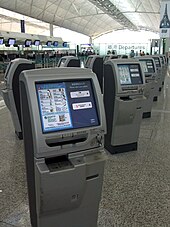
Source: Mk2010
Beginning in 2007, Cathay Pacific launched more methods to check in for flights. Among them were self-check-in using a kiosk at Hong Kong International Airport and other select destinations and checking in via a mobile phone. Cathay Pacific also launched a mobile application on App Store and Google Play, formerly named CX Mobile. Passengers can use the application to check flight arrivals and departures, check in for their flights and read about the destinations they are flying to using City Guides. The app has become a hit with passengers, making Cathay Pacific one of the industry leaders in offering mobile services to users of smartphones.
Cathay Pacific is also now following a trend among many airlines to improve its brand image to customers and shareholders with social media, and is ranked fourth worldwide. The airline now uses a range of social media tools including Facebook, Flickr, Twitter, Instagram, YouTube and blogging to share ideas with customers. In addition, it has launched a virtual tour to enable passengers to experience Cathay Pacific’s new cabins and services without having to step aboard the aircraft.
On 4 January 2011, the cargo division of the airline, Cathay Pacific Cargo, became the first airline operating out of Hong Kong to fully switch to e-air waybill. This eliminates the need for all paper documents when issuing air waybills. The International Air Transport Association (IATA) selected nine countries and territories and airlines in which to run the e-AWB pilot program, including Hong Kong and Cathay Pacific.
Cabin
First class

Source: Raymondeuro
First Class is available solely on board select Boeing 777-300ER aircraft, and features 6 seats in a 1-1-1 configuration. The first-class seats can be converted into fully lie-flat beds measuring 36 in × 81 in (91 cm × 206 cm). The seats include a massage function, a personal closet, an ottoman for stowage or guest seating, and adjustable 18.5 in (47 cm), HD personal televisions (PTV).
Business class

Source: Sunnya343
Cathay Pacific introduced a new Business Class seat in 2011, featuring reverse herringbone seating in a 1-2-1 configuration. Each seat converts into a fully flat bed of length 82 inches (208 cm), with a width of up to 21 inches (53 cm). Each seat features a small enclosed side cabinet, and an adjustable 18.5 in (47 cm( personal television.[134] In 2016, upon delivery of brand new Airbus A350s, Cathay Pacific introduced a refreshed reverse herringbone seat designed by Porsche Design, with HD personal televisions and additional enclosed storage space on the side.
The new Regional Business Class is provided on Cathay Pacific’s regionally configured Boeing 777s (excluding the 777–300ER) and selected Airbus A330-300s. Regional Business Class seats have 21 in (53 cm) width and recline to 47 in (120 cm) of pitch and feature electrical recline and leg rest. A 12 in (30 cm) PTV is located in the seat back offers AVOD.
Premium Economy class
Cathay Pacific introduced a Premium Economy Class in March 2012. The seat pitch is 38 inches – six inches more than Economy Class – and the seat itself is wider and have a bigger recline. It has a large meal table, cocktail table, footrest, a 10.6-inch personal television, an in-seat power outlet, a multi-port connector for personal devices, and extra personal stowage space. The Premium Economy Class seat offers a higher level of comfort with more living space in a separate cabin before the Economy Class zone.
In 2016, on delivery of the Airbus A350-900 fleet, Cathay Pacific introduced a new Premium Economy seat, which features a 12.1 in (31 cm) HD PTV, and improved pitch of 40 inches (102 cm). The new seats are configured in a 2-4-2 configuration, with a width of 18.5 in (47 cm).
Economy class
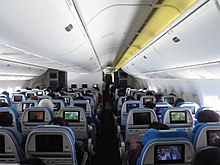
Source:
N509FZ
Cathay Pacific introduced a new economy class in March 2012. They have a six-inch recline (two inches over the current long-haul economy seat). These seats are 17.5 in (44 cm) in width and have 32 in (81 cm) of pitch.
The old Economy Class seats, offered on aircraft outfitted with the refurbished long-haul interiors, were designed by B/E Aerospace and introduced in July 2008. These seats include a fixed back design (shell) that allows passengers to recline without intruding on those seated behind, a 9 in (23 cm) PTV providing AVOD, AC power located behind a larger tray table, a coat hook and a literature pocket that has been relocated to below the seat cushion to create more legroom. The fixed shell of these seats has been criticised. The previous Economy Class seats each feature 6 in (15 cm) PTVs with a choice of 25 channels. These seats are 17 in (43 cm) in width and have 32 in (81 cm) of pitch. These seats have been replaced with the new Economy Class seats on aircraft receiving the Cathay Pacific’s new long-haul interior configuration, where some regional aircraft continue to offer the old shell seats. Since 2017, all Boeing 777s are retrofitted from 9 abreast to 10 abreast, increasing the economy class seats on board the -300 from 356 to 396 seats & the -300ER from 182/268 seats to 201/296 seats. All new seats feature new 11.6-inch touch screens, USB ports, & improved seat pitch. The seat width is 17.2 in (44 cm).
In-flight entertainment
StudioCX, Cathay Pacific’s in-flight entertainment system, equipped with personal televisions (PTVs) in every seat, offers movies, Asian and Western TV programs, music and games. Also, the airline provides a range of different newspapers and magazines from around the world, including the airline’s in-flight magazine Discovery. Passengers with visual impairment can request for Hong Kong’s South China Morning Post in Braille to be available on board.
StudioCX provides Audio/Video on Demand (AVOD) for every passenger and offers up to 100 movies, 350 TV programs, about 1000 CD albums in 25 different genres, 25 radio channels and more than 70 interactive games.
Catering

Source: https://www.flickr.com/photos/richardmoross/

Source: Rintojiang
Food and beverages are complimentary on all flights, with two hot meals generally served on each flight for long haul flights, along with free alcoholic beverages.[149] Foods served on flights from Hong Kong are provided by Cathay Pacific Catering Services (CPCS) facilities in Hong Kong. CLS Catering Services Limited, a joint venture with LSG Sky Chefs, provides the inflight catering from Toronto and Vancouver airports; while Vietnam Air Caterers, a joint venture between CPCS and Vietnam Airlines, provides the inflight catering for flights from Ho Chi Minh City. For Manila-Hong Kong, they usually serve snacks in a snack bag, called a complimentary snack and drink. It contains a pastry or wrap in a box or a paper bag, an Anzac Cookie, an Antiseptic Towelette and a Nestea Lemon Tea for Taipei flights and a Sunkist Mango Juice or a Bottled Water for Manila flights. For flights to and from Taipei, a simplified lunch with hot rice is served, and the four varieties are served in rotation on flights.
Accidents and incidents
Cathay Pacific had eight incidents and accidents over its history, although none have resulted in a hull loss or loss of life since 1972.
- On 16 July 1948, Miss Macao, a Cathay Pacific-subsidiary-operated Consolidated PBY-5A Catalina (VR-HDT) from Macau to Hong Kong was hijacked by four men, who killed the pilot after take-off. The aircraft crashed in the Pearl River Delta near Zhuhai. Twenty-six people died, leaving only one survivor, a hijacker. This was the first hijacking of a commercial airliner in the world.
- On 24 February 1949, a Cathay Pacific Douglas DC-3 (VR-HDG) from Manila to Hong Kong, crashed near Braemar Reservoir after a go-around in poor weather. All 23 people on board died.
- On 13 September 1949, a Cathay Pacific Douglas DC-3 (VR-HDW) departing from Anisakan, Burma, crashed on take-off when the right-hand main gear leg collapsed. There were no reported fatalities.
- On 23 July 1954, a Cathay Pacific Douglas DC-4 (VR-HEU) from Bangkok to Hong Kong was shot down by aircraft of the People’s Liberation Army Air Force in the South China Sea near Hainan Island. Ten people died, leaving nine survivors. After the incident, Cathay Pacific received an apology and compensation from the People’s Liberation Army Air Force. It was apparently mistaken for a Nationalist Chinese military aircraft.
- On 5 November 1967, Cathay Pacific Flight 33, operated by a Convair 880 (VR-HFX) from Hong Kong to Saigon, overran the runway at Kai Tak Airport. One person was killed and the aircraft was written off.
- On 15 June 1972, Cathay Pacific Flight 700Z, operated by a Convair 880 (VR-HFZ) from Bangkok to Hong Kong, disintegrated and crashed while the aircraft was flying at 29,000 feet (8,800 m) over Pleiku, Vietnam after a bomb exploded in a suitcase placed under a seat in the cabin, killing all 81 people on board.
- On 13 April 2010, Cathay Pacific Flight 780, an Airbus A330-342 (B-HLL) from Surabaya Juanda International Airport to Hong Kong landed safely after both engines failed due to contaminated fuel. 57 passengers were injured in the ensuing slide evacuation. Its two pilots received the Polaris Award from the International Federation of Air Line Pilots’ Associations, for their heroism and airmanship.
- On 15 August 2018, a Cathay Pacific Boeing 777-300ER (B-KPY) damaged the edge of its right wing during pushback, by hitting a floodlight pole in Rome–Fiumicino Airport, causing severe damage. No injuries were reported.
Source: wikipedia
